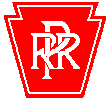 GG1 Technojargon
GG1 Technojargon
Why is it called the GG1?
The Pennsylvania Railroad had a standard system
for identifying locomotives by wheel arrangement. For example a
4-6-2 was a K, a 2-10-0 was an I, a 2-8-2 was a L. subsequent models
would get a number such as K2, K3, K4. Of importance here, is a 4-6-0
was a G. When articulated locomotives were introduced, either
electric or steam, it was classified as two locmotives back to back.
The GG1 is a 2-C+C-2 in Diesel terms, but a 4-6-0+0-6-4 in steams
terms, so it was two G lomotovies back to back, hence GG. First
revision makes it the GG1 (there was no GG2, but all electrics got
a trailing number, although all steamers did not.)
What is Quill Drive?
Quill drive refers to the hollow tube or 'quill' with disk shaped
plates on either end (one is a gear). The motors powering each axle
(two each in the G's case) apply power
to this qull rather than directly to the axle. The axle passes through
the quill and the spked wheels are just outside the quill plates.
The plates each have
six spring cups attached to their outside faces. They jut
out between the wheel spokes, with each end of a spring cup
cylinder facing each of the adjacent spokes. They apply the
power from the quill to the spokes, which spoke depending on the
direction of force applied. The axle can turn freely within
the quill, but only as far as the spring cups will allow it to.
In this way, as the quill and spring cups absorb the
shock from the motors, giving a smoother application
of power (better on the loco) and a smoother ride (better on
the track).
This is the way I understand it, anyway.
More modern locos with smaller and ligher motors have them
geared directly to the axles. Older
ones had jack shafts not unlike steam locomotive rods that conveyed
power without the motors resting directly on the axles. The GG1's
prececessor, the P5a, also used spring cups, but on only one wheel
per axle rather than two in the case of the GG1.
The distibution of the cups among two wheels per axle
eliminated many of the problems the P5a had with damaged and worn
out cups and broken axles.
 GG1 Technojargon
GG1 Technojargon GG1 Technojargon
GG1 Technojargon